[Michael relishes the opening of a new gallery showcasing emerging artists, which boasts a playful inspiration and a mix of lively works. — the artblog editors]
Horn & Hardart opened its doors in 1902 as the first automat in the United States. This German-inspired fast-food “restaurant” chain began at 818 Chestnut St., Philadelphia, a collaboration between Philadelphian Joseph Horn and German-born Frank Hardart. The concept was that customers would select a prepared food item from a coin-operated vending machine and instantly receive the food.
From food to fine art
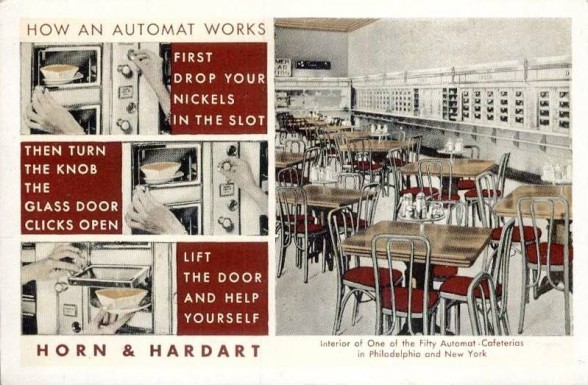
The Horn & Hardart chain declined in the 1960s with the rise of the suburbs and the advent of Burger Chef, McDonalds, and other fast food providers. Philadelphians should be excited to know we now have a new automat, although this AUTOMAT is an exhibition space, serving up rousing exhibitions and programming instead of food.
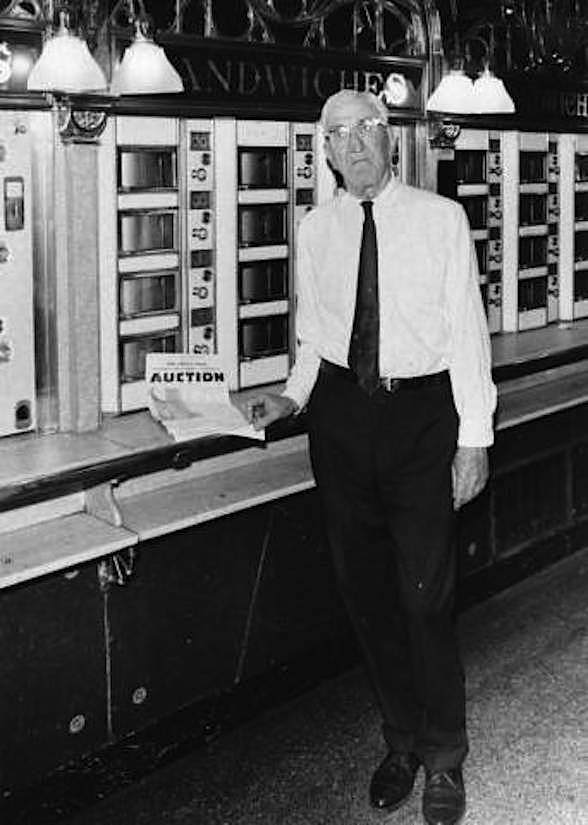
Material mashups
AUTOMAT began with an Indiegogo campaign that exceeded its goal and a mission statement that playfully suggests why the founders chose the name of their gallery: “Together, we process, package, and display for your convenience.”
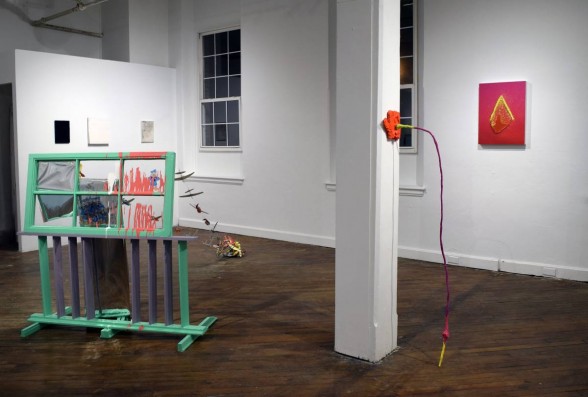
The inaugural exhibition at AUTOMAT is a fluid, multisensory experience. A harmonious use of materials, layering, and texture among the artists permeates the gallery, and because of this, the artwork feels cohesive and curated even though there’s a fair deal of scatter art that might seem disjointed. Also harmonious is the fact that all eight of AUTOMAT’s artist-members are graduates of Pennsylvania Academy or will graduate from PAFA’s MFA program this spring.
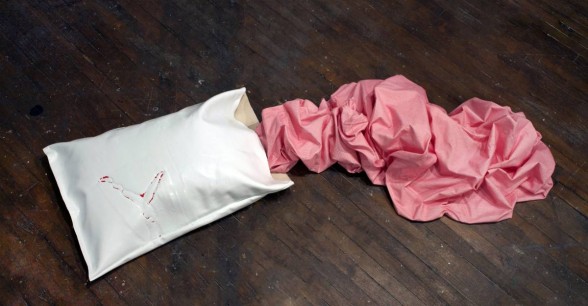
One constant in Hello, My Name is AUTOMAT is the playful use of materials. Jillian Schley’s “Slip” instills a thick application of latex and acrylics overtop a canvas pillowcase or envelope open at one end. The pillowcase/envelope glows bright white against the dark wood floor. A bunched-up, pink, blanket-like dress slip tossed on the floor seems to be coming out of or going into the pillowcase. The textural contrast between the smooth painted canvas, the woven fibers of the pink fabric and the wooden floor is a nice formal contrast. The harmonious placement of materials suggests a bed that is absurdly enticing yet completely impractical–a trap waiting for the next sucker who slips in under the sheets.
Trying to glimpse within
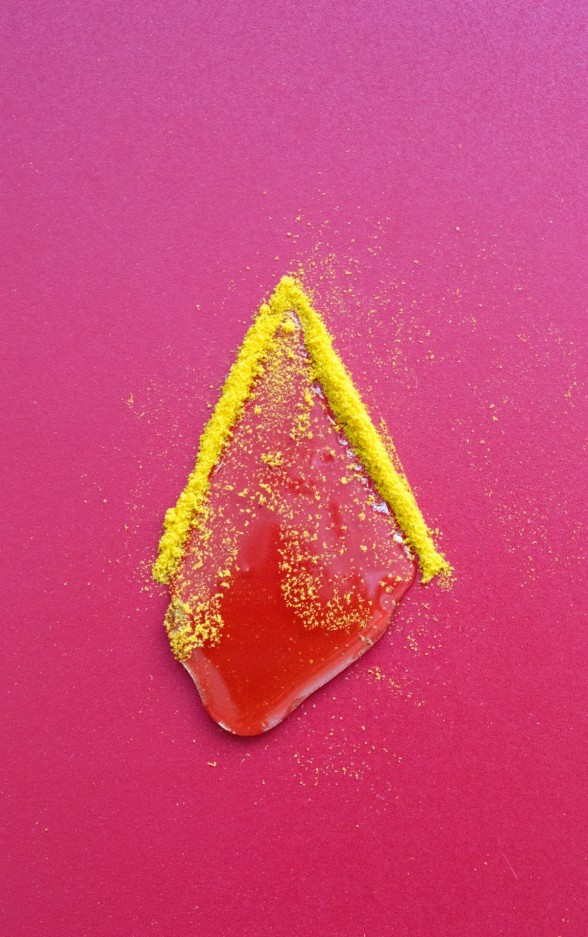
Nearby on the wall, the abstract illusion produced by Tiffany Tate called “the climb” is materials’ sorcery. The piece, which is a photograph, replicates the shallow relief of a poured red liquid pigment and its shadow and an inverted “V” of yellow powder so convincingly that it took me a few moments to confirm that it was indeed a photograph.
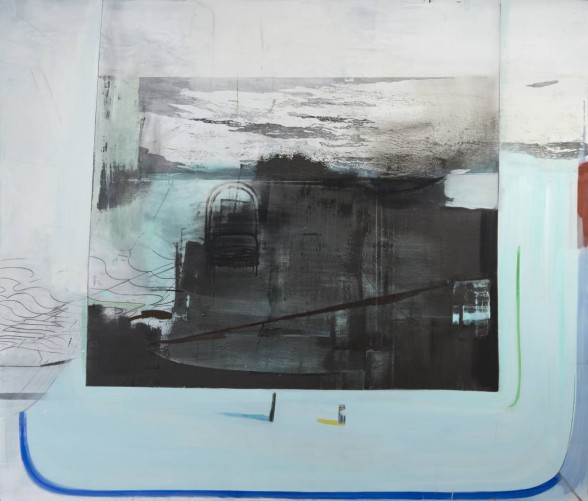
Rebecca Sedehi’s sizeable painting “Nomads” towers over the gallery. The piece suggests a window framing the central image. The bottom of the frame has rounded corners that resemble old-fashioned slide images. Inside the frame is a dark, abstracted space that might be a vacant room in which a solitary chair sits off center. An overlay of crudely fashioned cracks and wispy clouds evokes the organic textures found on degraded nitrate film. This overlay obstructs a clear viewing of the chair and its surroundings, and thus further skews the painting’s dark, isolated atmosphere.
Peering at the murky center of “Nomads” is like trying to look through dirty glass. The glass obfuscates, and so does Sedehi’s meaning. Her mark-making and Expressionist brushwork conceal identifiable touchstones that would otherwise illuminate the meaning sealed behind that grime. She limits viewers by allowing them to only scratch the surface of the painting’s significance. Intentional or not, the limited visual information Sedehi provides emulates–what I imagine to be–the experience of putting a coin into an out-of-order vending machine at one of AUTOMAT’s restaurant predecessors.
Thoughtful, occasionally somber works
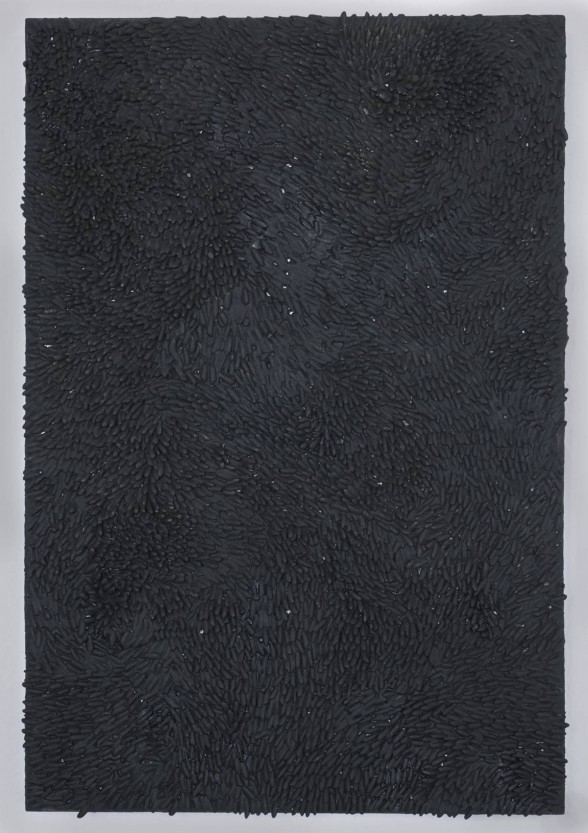
The eerie tone of “Nomads” resonates with Emily Elliott’s starkly colored, tactile panels. Her “Aggregate Particulate” is a sculptural painting with a limited palette (black and blacker). What is most noticeable is the piece’s texture–generated by rice in the paint. The artist has positioned the rice into undulating ripples that appear to swim with the vivacity of fish. The visual patterns Elliott presents are simple and meditative. They act as somber breaks from the rest of the exhibition.
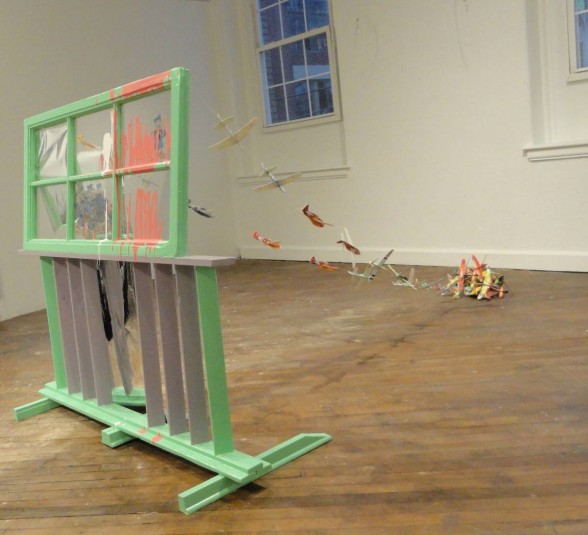
At the center of AUTOMAT lies Zach Zecha’s “Planes for Tomorrow,” an installation grounded on one side by a window whose glass panes are obscured by stickers and paint and on the other by a pile of mini paper airplanes sitting on the floor. The planes, attached to the top of the window, “fly” in chain formation and dive down into a mini-plane pileup. At a time when more people travel by air and planes disappear or crash with seeming regularity, I wonder if this work begs viewers to stop turning a blind eye to the issue of flight safety or begs the airlines and regulators to take precautions for the future. Maybe both. Regardless, “Planes for Tomorrow” tackles exactly what the title says in a very literal manner as if to ponder why this blatantly obvious question needs to be addressed in the first place.
The aesthetic throughout Hello, My Name is AUTOMAT combines aspects of Pop Art color use with Minimalist compositions that limit the senses and the exploration of materiality, like Arte Povera. These many working parts come together for an interactive and engaging show. AUTOMAT opens its doors with an exceptional exhibition that is sure to score countless regulars returning for another morsel of what the gallery has to dish out.
Hello, My Name is AUTOMAT is open at AUTOMAT Gallery, 319 N 11th St. 2i, Philadelphia, from April 3 – May 22, 2015. AUTOMAT includes artists Nadine Beauharnois, Emily Elliott, Morgan Hobbs, Jillian Schley, Rebecca Sedehi, Shane Allan Smith, Tiffany Tate, and Zach Zecha.









